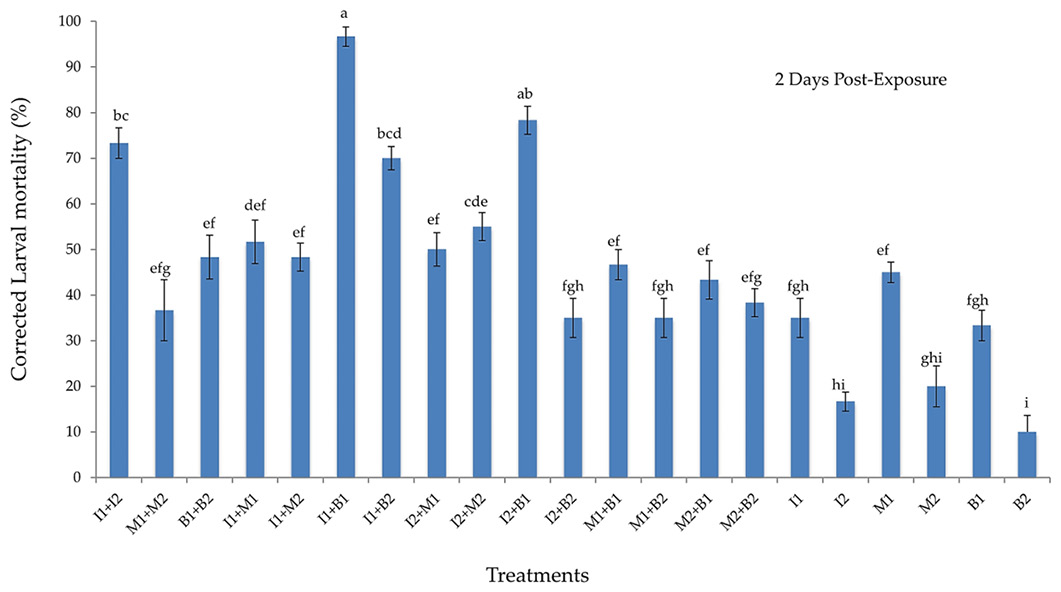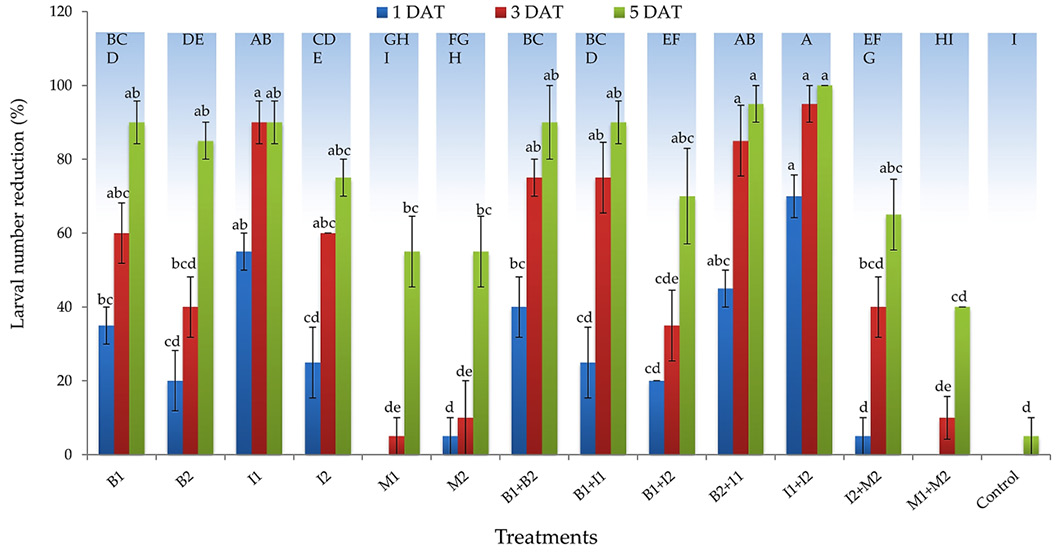Combined Efficacy of Biorational Insecticides against Potato Leafworm Spodoptera litura Fabricius (Lepidoptera: Noctuidae) Under Laboratory and Field Conditions
Combined Efficacy of Biorational Insecticides against Potato Leafworm Spodoptera litura Fabricius (Lepidoptera: Noctuidae) Under Laboratory and Field Conditions
Muhammad Shakil Ahmad1, Muhammad Afzal1, Liu Yu Feng2, Muhammad Shahroaz Khan1 and Muhammad Zeeshan Majeed1*
Corrected percent mortality (mean ± S.E.; N = 6) of 3rd instar larvae of Spodoptera litura bioassayed against different biorational synthetic, botanical and microbial insecticides alone and in binary combinations. I1= flubendiamide, I2= spinetoram, B1= Azadirachta indica oil, B2= Nicotiana tabacum oil, M1= Bacillus thuringensis kurstaki, M2= Spodoptera litura–NPV. Alphabets at bar tops indicate significant difference among the treatments (one-way factorial ANOVA followed by Tukey’s post-hoc test HSD at α= 0.05).
Corrected percent mortality (mean ± S.E.; N = 6) of 3rd instar larvae of Spodoptera litura bioassayed against different biorational synthetic, botanical and microbial insecticides alone and in binary combinations. I1= flubendiamide, I2= spinetoram, B1= Azadirachta indica oil, B2= Nicotiana tabacum oil, M1= Bacillus thuringensis kurstaki, M2= Spodoptera litura–NPV. Alphabets at bar tops indicate significant difference among the treatments (one-way factorial ANOVA followed by Tukey’s post-hoc test HSD at α= 0.05).
Percent reduction (mean ± S.E.; N = 4, n = 40) in Spodoptera litura larval numbers on the potato plants recorded at different time intervals post-treatment by different biorational synthetic, botanical and microbial insecticides alone and in binary combinations in winter 2019. I1 = flubendiamide, I2 = spinetoram, B1= Azadirachta indica oil, B2 = Nicotiana tabacum oil, M1 = Bacillus thuringensis kurstaki, M2 = Spodoptera litura–NPV. Small and capital alphabets indicate significant difference among the treatments for each DAT and overall among the treatments, respectively (factorial ANOVA followed by Tukey’s post-hoc test HSD at α= 0.05).
Percent reduction (mean ± S.E.; N = 4, n = 40) in Spodoptera litura larval numbers on the potato plants recorded at different time intervals post-treatment by different biorational synthetic, botanical and microbial insecticides alone and in binary combinations in winter 2020. I1 = flubendiamide, I2 = spinetoram, B1 = Azadirachta indica oil, B2 = Nicotiana tabacum oil, M1 = Bacillus thuringensis kurstaki, M2 = Spodoptera litura–NPV. Small and capital alphabets indicate significant difference among the treatments for each DAT and overall among the treatments, respectively (factorial ANOVA followed by Tukey’s post-hoc test HSD at α= 0.05).











